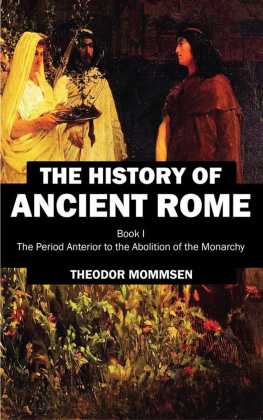Theodor Mommsen - The history of Rome
Here you can read online Theodor Mommsen - The history of Rome full text of the book (entire story) in english for free. Download pdf and epub, get meaning, cover and reviews about this ebook. genre: Science. Description of the work, (preface) as well as reviews are available. Best literature library LitArk.com created for fans of good reading and offers a wide selection of genres:
Romance novel
Science fiction
Adventure
Detective
Science
History
Home and family
Prose
Art
Politics
Computer
Non-fiction
Religion
Business
Children
Humor
Choose a favorite category and find really read worthwhile books. Enjoy immersion in the world of imagination, feel the emotions of the characters or learn something new for yourself, make an fascinating discovery.

- Book:The history of Rome
- Author:
- Genre:
- Rating:4 / 5
- Favourites:Add to favourites
- Your mark:
- 80
- 1
- 2
- 3
- 4
- 5
The history of Rome: summary, description and annotation
We offer to read an annotation, description, summary or preface (depends on what the author of the book "The history of Rome" wrote himself). If you haven't found the necessary information about the book — write in the comments, we will try to find it.
The history of Rome — read online for free the complete book (whole text) full work
Below is the text of the book, divided by pages. System saving the place of the last page read, allows you to conveniently read the book "The history of Rome" online for free, without having to search again every time where you left off. Put a bookmark, and you can go to the page where you finished reading at any time.
Font size:
Interval:
Bookmark:
version="1.0" encoding="windows-1251"?>sci_historysci_cultureTheodorMommsenThe history of Rome
The History of Rome by Theodor Mommsen, translated by William Purdie Dickson
endeshoomowFB Editor v2.0, FB Writer v1.124 July 2009C8271AB5-7AC0-4C14-B899-BBE89ACD604E1.0Ver 1.0 - , (The Project Gutenberg, www.gutenberg.net). (David Ceponis).
Theodor Mommsen
The history of Rome. Book IV
THE HISTORY OF ROME. BOOK IV
The Revolution
by THEODOR MOMMSEN
Translated with the Sanction of the Author
by William Purdie Dickson, D.D., LL.D. Professor of Divinity in the University of Glasgow
Preparer's Note
This work contains many literal citations of and references to words, sounds, and alphabetic symbols drawn from many languages, including Gothic and Phoenician, but chiefly Latin and Greek. This English language Gutenberg edition, constrained within the scope of 7-bit ASCII code, adopts the following orthographic conventions:
1) Words and phrases regarded as "foreign imports", italicized in the original text published in 1903; but which in the intervening century have become "naturalized" into English; words such as "de jure", "en masse", etc. are not given any special typographic distinction.
2) Except for Greek, all literally cited non-English words that do not refer to texts cited as academic references, words that in the source manuscript appear italicized, are rendered with a single preceding, and a single following dash; thus, -xxxx-.
3) Greek words, first transliterated into Roman alphabetic equivalents, are rendered with a preceding and a following double-dash; thus, --xxxx--. Note that in some cases the root word itself is a compound form such as xxx-xxxx, and is rendered as --xxx-xxx--
4) Simple non-ideographic references to vocalic sounds, single letters, or alphabeic dipthongs; and prefixes, suffixes, and syllabic references are represented by a single preceding dash; thus, -x, or -xxx.
5) The following refers particularly to the complex discussion of alphabetic evolution in Ch. XIV: Measuring And Writing). Ideographic references, meaning pointers to the form of representation itself rather than to its content, are represented as -"id:xxxx"-. "id:" stands for "ideograph", and indicates that the reader should form a mental picture based on the "xxxx" following the colon. "xxxx" may represent a single symbol, a word, or an attempt at a picture composed of ASCII characters. E. g. --"id:GAMMA gamma"-- indicates an uppercase Greek gamma-form Followed by the form in lowercase. Some such exotic parsing as this is necessary to explain alphabetic development because a single symbol may have been used for a number of sounds in a number of languages, or even for a number of sounds in the same language at different times. Thus, -"id:GAMMA gamma" might very well refer to a Phoenician construct that in appearance resembles the form that eventually stabilized as an uppercase Greek "gamma" juxtaposed to another one of lowercase. Also, a construct such as --"id:E" indicates a symbol that in graphic form most closely resembles an ASCII uppercase "E", but, in fact, is actually drawn more crudely.
6) The numerous subheading references, of the form "XX. XX. Topic" found in the appended section of endnotes are to be taken as "proximate" rather than topical indicators. That is, the information contained in the endnote indicates primarily the location in the main text of the closest indexing "handle", a subheading, which may or may not echo congruent subject matter.
The reason for this is that in the translation from an original paged manuscript to an unpaged "cyberscroll", page numbers are lost. In this edition subheadings are the only remaining indexing "handles" of sub-chapter scale. Unfortunately, in some stretches of text these subheadings may be as sparse as merely one in three pages. Therefore, it would seem to make best sense to save the reader time and temper by adopting a shortest path method to indicate the desired reference.
7) Dr. Mommsen has given his dates in terms of Roman usage, A.U.C.; that is, from the founding of Rome, conventionally taken to be 753 B. C. To the end of each volume is appended a table of conversion between the two systems.
CONTENTS
BOOK IV: The Revolution
I. The Subject Countries Down to the Times of the Gracchi
II. The Reform Movement and Tiberius Gracchus
III. The Revolution and Gaius Gracchus
IV. The Rule of the Restoration
V. The Peoples of the North
VI. The Attempt of Marius at Revolution and the Attempt of Drusus at Reform
VII. The Revolt of the Italian Subjects, and the Sulpician Revolution
VIII. The East and King Mithradates
IX. Cinna and Sulla
X. The Sullan Constitution
XI. The Commonwealth and Its Economy
XII. Nationality, Religion, and Education
XIII. Literature and Art
BOOK FOURTH
The Revolution
"Aber sie treiben's toll;
Ich furcht', es breche".
Nicht jeden Wochenschluss
Macht Gott die Zeche.
GoetheChapter I
The Subject Countries Down to the Times of the Gracchi
With the abolition of the Macedonian monarchy the supremacy of Rome not only became an established fact from the Pillars of Hercules to the mouths of the Nile and the Orontes, but, as if it were the final decree of fate, it weighed on the nations with all the pressure of an inevitable necessity, and seemed to leave them merely the choice of perishing in hopeless resistance or in hopeless endurance. If history were not entitled to insist that the earnest reader should accompany her through good and evil days, through landscapes of winter as well as of spring, the historian might be tempted to shun the cheerless task of tracing the manifold and yet monotonous turns of this struggle between superior power and utter weakness, both in the Spanish provinces already annexed to the Roman empire and in the African, Hellenic, and Asiatic territories which were still treated as clients of Rome. But, however unimportant and subordinate the individual conflicts may appear, they have collectively a deep historical significance; and, in particular, the state of things in Italy at this period only becomes intelligible in the light of the reaction which the provinces exercised over the mother-country.
SpainExcept in the territories which may be regarded as natural appendages of Italy - in which, however, the natives were still far from being completely subdued, and, not greatly to the credit of Rome, Ligurians, Sardinians, and Corsicans were continually furnishing occasion for "village triumphs" - the formal sovereignty of Rome at the commencement of this period was established only in the two Spanish provinces, which embraced the larger eastern and southern portions of the peninsula beyond the Pyrenees. We have already.
Carteia was founded in 583 and owed its existence to the multitude of camp-children - the offspring of Roman soldiers and Spanish slaves - who grew up as slaves de jure but as free Italians de facto, and were now manumitted on behalf of the state and constituted, along with the old inhabitants of Carteia, into a Latin colony. For nearly thirty years after the organizing of the province of the Ebro by Tiberius Sempronius Gracchus (575, 576) the Spanish provinces, on the whole, enjoyed the blessings of peace undisturbed, although mention is made of one or two expeditions against the Celtiberians and Lusitanians.
Lusitanian WarBut more serious events occurred in 600. The Lusitanians, under the leadership of a chief called Punicus, invaded the Roman territory, defeated the two Roman governors who had united to oppose them, and slew a great number of their troops. The Vettones (between the Tagus and the Upper Douro) were thereby induced to make common cause with the Lusitanians; and these, thus reinforced, were enabled to extend their excursions as far as the Mediterranean, and to pillage even the territory of the Bastulo-Phoenicians not far from the Roman capital New Carthage (Cartagena). The Romans at home took the matter seriously enough to resolve on sending a consul to Spain, a step which had not been taken since 559; and, in order to accelerate the despatch of aid, they even made the new consuls enter on office two months and a half before the legal time. For this reason the day for the consuls entering on office was shifted from the 15th of March to the 1st of January; and thus was established the beginning of the year, which we still make use of at the present day. But, before the consul Quintus Fulvius Nobilior with his army arrived, a very serious encounter took place on the right bank of the Tagus between the praetor Lucius Mummius, governor of Further Spain, and the Lusitanians, now led after the fall of Punicus by his successor Caesarus (601). Fortune was at first favourable to the Romans; the Lusitanian army was broken and their camp was taken. But the Romans, partly already fatigued by their march and partly broken up in the disorder of the pursuit, were at length completely beaten by their already vanquished antagonists, and lost their own camp in addition to that of the enemy, as well as 9000 dead.
Next pageFont size:
Interval:
Bookmark:
Similar books «The history of Rome»
Look at similar books to The history of Rome. We have selected literature similar in name and meaning in the hope of providing readers with more options to find new, interesting, not yet read works.
Discussion, reviews of the book The history of Rome and just readers' own opinions. Leave your comments, write what you think about the work, its meaning or the main characters. Specify what exactly you liked and what you didn't like, and why you think so.





